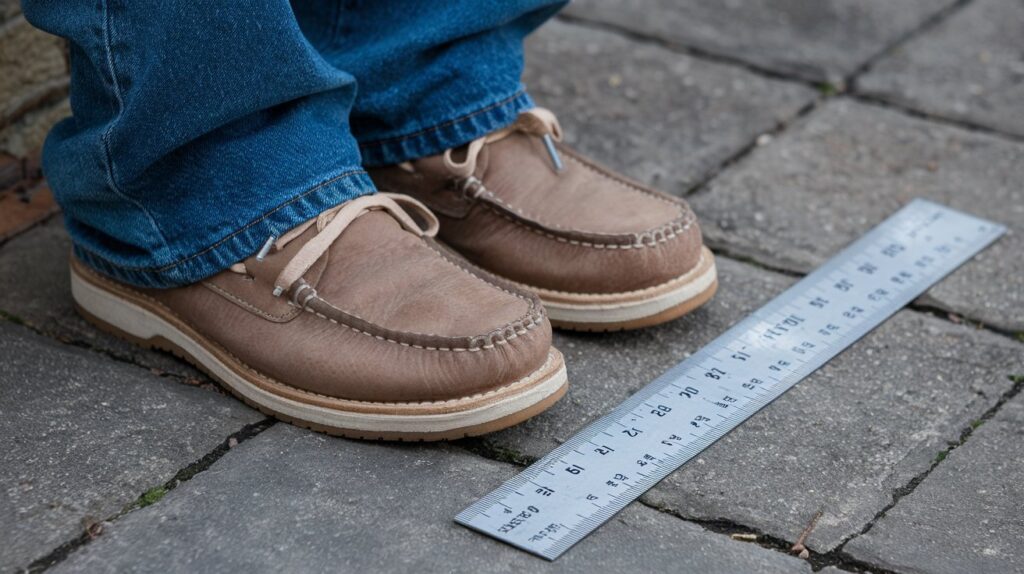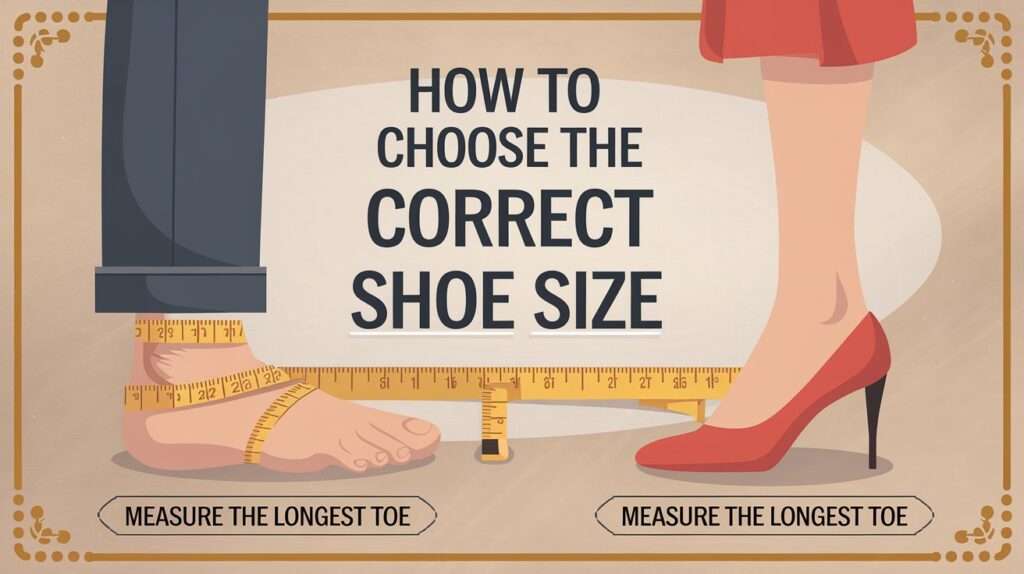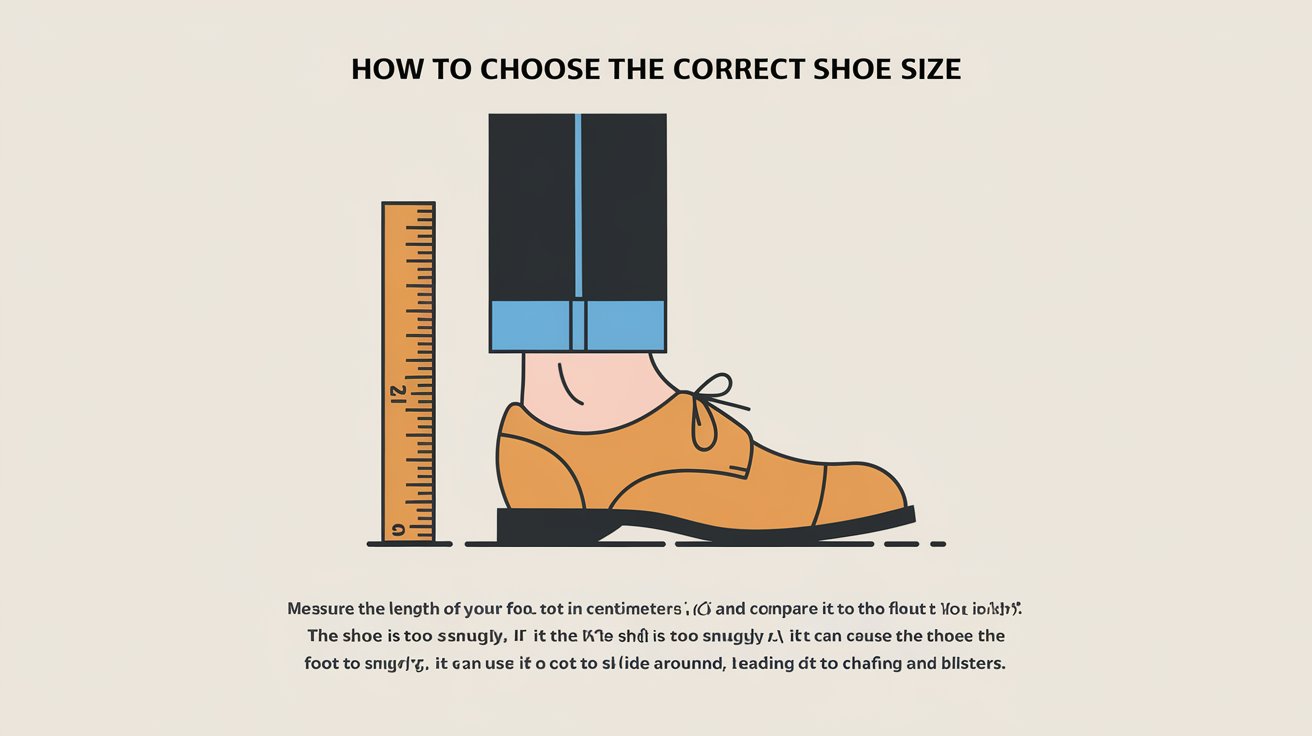Choosing the correct shoe size is essential for comfort, support, and long-term foot health. Ill-fitting shoes can cause blisters, pain, and even chronic foot issues. Here’s a comprehensive guide to help you find the perfect fit every time.
Step 1: Understand Shoe Size Systems
Shoe sizes vary across countries and brands. Here are the key systems to understand:
- US Sizes:
- Separate categories for men, women, and kids.
- Women’s sizes are typically 1.5 sizes larger than men’s.
- UK Sizes:
- Slightly smaller than US sizes (e.g., UK size 6 = US size 7).
- EU Sizes:
- Measured in centimeters and are unisex (e.g., EU 38 fits both men and women).
- Japan Sizes:
- Directly based on foot length in centimeters.
Always check the brand-specific size chart to avoid confusion.
Step 2: Measure Your Feet Accurately
Proper foot measurement is the foundation for choosing the right shoe size.

What You Need:
- A sheet of paper
- A pencil or pen
- A ruler or tape measure
- Socks (if applicable)
Steps:
- Place the Paper:
- Put the paper on a hard, flat surface.
- Stand with one foot on the paper.
- Trace Your Foot:
- Hold the pencil perpendicular to the paper.
- Trace the outline of your foot.
- Measure the Length:
- Use a ruler to measure from the heel to the tip of the longest toe.
- Measure the Width:
- Measure the widest part of your foot.
- Repeat for Both Feet:
- Feet can be slightly different in size; use the larger measurement.
Pro Tip:
- Measure your feet in the evening when they’re slightly swollen for the most accurate size.
Step 3: Use a Size Chart
Once you have your foot measurements, compare them with a size chart for the brand or country you’re shopping in.
Example Conversion Chart:
| Foot Length (cm) | US Women’s | US Men’s | EU Size | UK Size |
|---|---|---|---|---|
| 22 | 5 | 3.5 | 35 | 2.5 |
| 23 | 6 | 4.5 | 36 | 3.5 |
| 24 | 7 | 5.5 | 37.5 | 4.5 |
| 25 | 8 | 6.5 | 38.5 | 5.5 |
| 26 | 9 | 7.5 | 40 | 6.5 |
Step 4: Consider Foot Width
Width is as important as length when it comes to comfort. Common width categories include:
- Narrow (N): For slim feet.
- Medium (M): Standard width for most people.
- Wide (W): For broader feet.
- Extra Wide (XW): For very wide feet.
Check if the brand offers width options. Shoes that are too narrow can cause pain and restrict circulation.
Step 5: Test the Fit
Once you have the shoe in hand (or on your feet), test it for the following:
- Toe Space:
- Ensure there’s about a thumb’s width (1 cm) of space between your longest toe and the shoe’s front.
- Width Fit:
- The shoe should feel snug but not tight across the widest part of your foot.
- Heel Fit:
- Your heel should stay securely in place without slipping.
- Comfort While Walking:
- Walk around to check for any pinching, rubbing, or slipping.
Step 6: Account for Shoe Purpose
Different activities require different fits:
- Running Shoes: Allow extra room (about 0.5 cm) for foot expansion during activity.
- Hiking Boots: Ensure a secure fit with thick socks.
- Dress Shoes: These may fit snugly but should still offer enough space for comfort.
Step 7: Consider Brand and Style Variations

Not all brands or styles fit the same. Here’s why:
- Brand Differences: Some brands run smaller or larger than others.
- Material: Leather may stretch over time, while synthetic materials may not.
- Design: Pointed-toe shoes require a larger size to avoid squishing toes.
Always read reviews or check brand-specific size guides for guidance.
Step 8: Try On Shoes Later in the Day
Feet naturally swell throughout the day. Trying on shoes in the afternoon or evening ensures they’ll fit comfortably during peak activity.
Step 9: Break Them In (If Needed)
While shoes should feel comfortable from the start, some materials like leather may require a short break-in period. Wear them for short periods initially to allow them to mold to your feet.
Common Mistakes to Avoid
- Skipping Foot Measurement:
- Even if you know your size, foot size can change over time due to factors like weight changes or aging.
- Ignoring Width:
- Don’t settle for shoes that are too narrow or too wide.
- Assuming All Sizes Are the Same:
- Sizing varies by brand, style, and country.
- Not Trying Both Shoes:
- One foot may be larger than the other; always try both shoes.
FAQs About Choosing the Correct Shoe Size
1. How often should I measure my feet?
- Measure your feet at least once a year, especially if you notice discomfort or changes in fit.
2. What if I’m between sizes?
- Go up to the next size for comfort and use insoles if needed.
3. How can I tell if my shoes are too small?
- Look for signs like pinching, toe cramping, or heel pain.
4. Can shoe size change with age?
- Yes, feet can flatten and expand over time, especially with aging or pregnancy.
Conclusion
Choosing the correct shoe size involves understanding sizing systems, measuring your feet accurately, and considering factors like width and shoe purpose. By following these steps, you can ensure every pair you buy fits comfortably and supports your foot health.



Leave a Reply